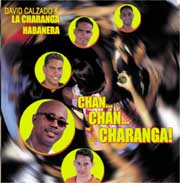Lo Nuevo[hide]
Reportes: From The St... : Cubadisco 2...
Fotos: Tom Ehrlich
Staff: Kristina Lim
Musicos: Juan Formell
Musicos: Yordamis Megret Planes
Musicos: Yasser Morejón Pino
Musicos: José Luis "Changuito" Quintana...
Musicos: Dennis Nicles Cobas
Fotos: Eli Silva
Grupos: Ritmo Oriental : 1988 - Vol. IX - 30 a...
Musicos: Rafael Paseiro Monzón
Musicos: Jiovanni Cofiño Sánchez
Fotos: Tom Ehrlich : 2024 Monterey Jazz, P...
Resenas: Vacilón Santiaguero (Circle 9 ...
Fotos Del Día [hide]
SpanishEnglishHistory - The Breakup and Beyond
La Charanga Habanera - La Desintegración en Adelante
por Kevin Moore
traducido al español por Ilán Greenfield
El presente relato retoma la historia de La Charanga Habanera desde el fatídico concierto de agosto 1997 que resultaría en una suspensión impuesta por el gobierno de tocar en público por seis meses.
Casi inmediatamente después de esto, el pianista y arreglista de la banda, Juan Carlos González, y el cantautor Dany Lozada, abandonan el grupo y forman «Dany Lozada y su Timba Cubana». Este conjunto graba el disco «Tanto Le Pedí». Muchos aficionados de la timba ni siquiera están al tanto de su existencia, pero es uno de los grandes tesoros, y es el sucesor más directo de «Tremendo Delirio», aún más cercano a dicha obra que los lanzamientos subsecuentes de mayor renombre de La Charanga Forever y la Charanga Habanera continuada por Calzado. De hecho, al momento de ser suspendido, el grupo que había grabado «Tremendo Delirio» ya estaba interpretando porciones del material que posteriormente aparecería en «Tanto Le Pedí». Este fue el único disco producido por González y Lozada. Tendremos un artículo más completo próximamente.
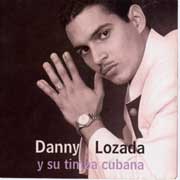
Dany Lozada - Tanto le pedí
Cuando González y Lozada se separan, Calzado los reemplaza prestamente y continúa ensayando y desarrollando material inédito durante la suspensión. El reemplazo de Lozada, Sandier Ante, también sería un compositor prolífico para la banda. Además de cantar sus propias canciones, Sandier toma el mando del tema éxito de Lozada: «Usa Condón». González, por su parte, es reemplazado por Roberto «Cucurucho» Carlos, otro compositor, y junto a Ante, se convierte en uno de los colaboradores principales de Calzado durante los once meses anteriores a la ruptura total de la banda. Cucurucho, que en el 2002 cuenta apenas 24 años, ha participado en no menos de seis grupos de timba: Charanga Habanera, Charanga Forever, Issac Delgado, Paulito F.G., Sol y Soul, y ahora Los Van Van. También deberíamos acotar que el excelente e innovador pailero Eduardo Lazaga abandona la CH después de Tremendo Delirio y lo substituye Gilberto Moreaux, proveniente de Bamboleo.
Esta segunda encarnación de la Charanga Habanera no pasa por los estudios de grabación, pero sí logra introducir material nuevo de excelente calidad, incluyendo «Jony», que sería eventualmente registrada por La Charanga Forever, al igual que «Chocolatera» y «Hay Que Comer La Habana», temas que desafortunadamente nunca fueron lanzados por nadie.
Aunque la partida de Lozada y González termina siendo el evento más significativo bajo un punto de vista musical, el evento que recibe mayor atención en la mente de los fervientes seguidores es la famosa desintegración de La Charanga Habanera, la cual ocurre un año después, durante el verano de 1998. El grupo renuncia en masa, en pocas palabras, con dos excepciones que permanecen fieles a David Calzado: el vocalista estrella Michel «El Menor de la Salsa» Maza, y el eterno sonidista Marcos Morales, que junto a la cantante y musicóloga Majela Serrano, ha sido absolutamente indispensable en nuestros esfuerzos por publicar la historia de La Charanga Habanera al internet. Morales quedaría junto al grupo durante siete años previo su traslado a Miami para juntarse con su familia a fines del 2000.
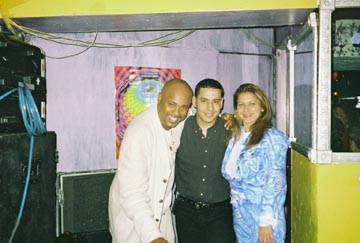
David Calzado, Marcos Morales, Aliet Calzado
Por lo cual en agosto de 1998 la menguante Charanga Habanera sólo contaba con un cantante principal, un cerebro de la música que ni siquiera cargaba un instrumento en manos mientras tocaba el grupo, y un sonidista fiel a la causa... Pero como lo diría el propio Morales desde su residencia en Miami: «el nombre Charanga Habanera es una marca registrada en Cuba, es como decir Coca Cola acá en los Estados Unidos». Cuando le pregunté ¿cómo hizo Calzado para incorporar a cuatro de los mejores músicos de Pachito Alonso?, Marcos repuso «sólo tenía que preguntar. Tocar en la Charanga Habanera es el sueño de todo músico joven ». Y es así como Calzado en poco tiempo, con mucha eficacia, y de manera brillante construye lo que aun en la actualidad es uno de los conjuntos más solventes y talentosos de la timba. En las pailas aparece el quinceañero prodigio Yulién Oviedo, hijo de Calixto Oviedo de NG La Banda. En las tumbadoras y bongó arriban los hermanos Mengual, Orlandito y Lázaro, de la percusión de Pachito Alonso. En el teclado se incorpora el excelente y joven músico de jazz, Helder Rojas. De Bamboleo llega el bajista Randolf Chacón, el que, si has asistido a uno de sus conciertos más recientes, baila y se bambolea con el bajo como si éste fuera de elástico. La sección de los metales es montada entonces, y cabe entre las más perfeccionistas de toda la historia de la música latina, juntándose el multitalentoso Osmani Collado (pianista, cantautor, saxofonista y flautista), Yunior Romero, también de Bamboleo, Juan Manuel Jiménez de Rojitas, y el miembro más viejo de la banda, Carmelo «El Abuelo» Andrés. Carmelo es un trompetista muy profesional que ya habría gozado de una exitosa trayectoria con Paulito y su Élite y Rojitas. Esto no es decir que los metales originales de La Charanga Habanera no tenían su calidad, pero Carmelo trajo consigo un nuevo grado de disciplina y precisión. Uno debe escuchar mucha salsa en vivo para apreciar la calidad de estos metales durante el concierto. A Michel Maza se le unen Aned Mota y Noel Díaz en la voz. Y así cómo así Calzado se encuentra rodeado de una banda totalmente nueva, compuesta de lo mejor de Cuba; verdedaros extraterrestres con una habilidad inaudita de aprenderse el material casi de inmediato y encarar en las más altas lides todas las demás bandas habaneras del momento. Pero con todo esto, también debemos considerar el genio de Calzado -- a más de su calidad de composición y su habilidad de ubicar y orientar el talento, también cuenta con un don asombroso de atraer a colaboradores brillantes y a cabalidad combinar distintas procedencias creativas con la suya propia. Calzado es el responsable del estilo único e inconfundible de la Charanga Habanera, pese a las contribuciones de muchas mentes creativas diferentes -- Juan Carlos González, evidentemente, fue el más significativo de ellos, pero también podemos mencionar a Limonta, Piloto, Manolín, Lozada, Arranz, Sombrilla, Alejandro y Rember, y muchos más. Calzado había juntado un grupo espectacular de músicos de altísimo nivel, pero aún le faltaba reemplazar el pulso creativo de González si quería realizar un digno sucesor de «Tremendo Delirio». Encontró lo que precisaba en el genio de Tirso Duarte, pianista, cantautor, compositor, etc., que en ese entonces acompañaba a Pachito Alonso en el teclado. Como lo veremos en el artículo sobre «El Charanguero Mayor», Duarte había maquinado una timba muy personal, con una nueva gama de ideas armónicas bastante distinta a la que estábamos acostumbrados a escuchar antes de su debut en esta banda. JC Gonzaléz, Ivan "Melón" González, Sergio Noroña... todos estos habían creado un estilo propio y muy original, y en cierta forma el estilo de Duarte incorpora muchas de las innovaciones de estos mismos intérpretes de mayor edad, pero lo que este joven de una nueva generación nos presenta, por su parte, no tiene nada que ver.
El 14 de septiembre de 1998, menos de dos meses de haber sido abandonado por todo su equipo musical (salvo un cantante y un sonidista), David Calzado y su Charanga Habanera se montan nuevamente al podio de La Tropical entre la élite de la timba. Una de las primeras contribuciones de Duarte es la canción «El Charanguero Mayor», el cual -- junto a una joya nunca lanzada en disco, «Confianza» -- representa el último par de canciones interpretadas por Michel Maza. Una maqueta de radio de este tema llega a causar cierto revuelo en La Habana, pero al momento de grabar el disco del mismo nombre, Maza ya sólo era un recuerdo lejano. Maza dejaría la agrupación a finales del 98. En la versión oficial del disco, la parte de Michel es repartida entre no menos de cinco cantantes, incluyendo el polifacético Yulién. Maza es reemplazado por Dantes «Riki Ricón» Cardosa y con esta formación se graba «Charanguero Mayor», que ha recibido también un análisis exhaustivo de nuestra parte. Este disco es lanzado en Perú como «El Baile del Azúcar», en el cual los temas aparecen en un orden distinto, algunos han cambiado curiosamente de título, pero las grabaciones son las mismas, salvo una descarga adicional en vivo titulada «El Baile del Azúcar».
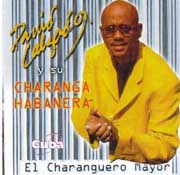
2000 - Charanguero Mayor
La banda continúa a desarrollar su material inédito, pero Tirso Duarte deja la banda en enero del 2000, antes de que Calzado y sus nuevos charangueros vuelvan a los estudios. En la actualidad Osmani Collado combina el teclado con el saxo y Helder Rojas se ha trasladado al piano. Las tareas vocales de Tirso son ahora responsabilidad de Leonid Torres, la flamante adquisición. El lanzamiento del 2001, que también incluye mucho material de Duarte, se titula «Tiene de Cuba, Tiene Mela'o» en Cuba y «Chan Chan Charanga» en los EE.UU.
Ya que hemos llegado al 2002 con La Charanga Habanera, volvamos al verano de 1998 para averiguar lo que sucedió con los charangueros originales que se habrían separado. Casi a paso seguido de haber dejado la banda, estaban preparados para tocar de nuevo. Lo único que les faltaba era un nombre -- se decidieron por «Charanga Forever»-- y un cantante que reemplace a Michel -- Armando Cantero. Siguieron grabando, utilizando material post-Tremendo Delirio y añadiendo el nuevo material de Cucurucho, Sandier Ante, Arranz, Sombrilla, y hasta Alejandro y Rember, colaboradores anteriores de Calzado. Así se produjo entonces «La Charanga Soy Yo», que pronto será motivo de análisis aquí en timba.com. En todo caso, Charanga Forever y Dany Lozada cuentan con páginas propias.
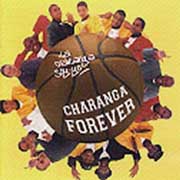
2000 - La Charanga Soy Yo
Pero el «baile de la silla» sólo venía de empezar... JC González y Dany Lozada rompieron sus vínculos en noviembre de 1998, y a inicios de 1999, Cucurucho y Sandier Ante dejaron la Forever, a poco tiempo de participar en «La Charanga Soy Yo». Era sólo cuestión de tiempo entonces para que González y Maza se reintegraran al grupo de sus viejos compinches. Para esto ya se habría grabado «La Charanga Soy Yo», pero todavía no había sido impresa, lo cual esclarece el misterio de por qué González y Michel aparecen en la portada de un disco que no cuenta con su participación.
Es interesante porque el famoso disco de la «bola de basquet» de hecho tuvo un papel muy importante en la historia de timba.com. Yo había comprado una copia pirata del disco en La Habana que, sin que yo lo sepa, contenía dos temas extra: eran maquetas de «Somos La Charanga» y «La Menor» que de hecho sí incluían a González y Michel. La cinta pirata tenía una copia xerox de la portada con la bola de basquet, pero no incluía documentación alguna. Inmediatamente después de escuchar el tema #5, «Somos La Charanga», supe que se trataba de uno de los temas timberos más calientes que existen e inmediatamente se lo mandé a Bruce Ishikawa para que publique al menos una versión de mala calidad en mp3, ¡a fin de que el mundo pueda, por lo menos, saber de su existencia! Después de esto, la lista de canciones del lanzamiento oficial de «La Charanga Soy Yo» empezó a aparecer en el internet, pero no sabíamos que la versión oficial del disco había omitido «Somos la Charanga» (espero no haberte perdido aún). Pues contamos hasta el tema #5, y llegamos a la conclusión equivocada de que la increíble «Somos La Charanga» se titulaba «Me Criticas». Fue esta suposición que resultó en el azaroso correo electrónico de un misterioso musicólogo residente en Alemania que nos señalaba nuestro gran error. El musicólogo se trataba, nada más ni nada menos, que de Majela Serrano, quién, después de Marcos Morales, sabe más de la Charanga Habanera que nadie en todo este mundo y el otro, y es nuestra fuente principal para la información vasta y completa que hemos podido proporcionarles en éste su espacio de música cubana, timba.com. Majela también ha producido una serie de biografías sobre cada uno de los miembros de La Charanga Habanera actual, las cuales aparecen en la sección de «Charangueros de Ayer y de Hoy». También es la cantante talentosa de Havana Open, un grupo cubano radicado en Europa.
Y así, irónicamente, la primera Charanga Forever fue formada de músicos de la segunda Charanga Habanera, mientras que la segunda Charanga Forever es de hecho una reunión casi completa de la Charanga Habanera original que grabó «Pa' que se entere La Habana». «La Charanga que tú conoces, la que siempre te sofocó». JC González, Pedro Pablo, Sombrilla, Michel, Polledo, Manolito, Vitico y cia., se juntarían nuevamente para editar un disco breve pero brillante bajo contrato de una disquera francesa. Este disco incluye la admirable «Somos la Charanga», que resulta ser compuesta por el propio Juan Formell. De hecho, en el lanzamiento francés el título del tema aparece como «Dice Formell». También contiene una gran canción de Limonta «El Avión» que la Charanga Haanera solía interpretar mucho en vivo pero que nunca llegó a grabar, al igual que la excelente «La Menor» y otros temas más de mucho interés.
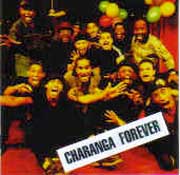
2000 - Charanga Forever
Lamentablemente, esta banda no duró, y la banda que hoy por hoy se conoce en Cuba como «La Charanga Forever» sólo cuenta con Sombrilla, Polledo y Victor Segarra de la Charanga Habanera original. JC González se ha trasladado a Italia, Pedro Pablo tiene un grupo nuevo, «Rebambaramba». Manolito Arranz, Sandier Ante y posiblemente otros ex-integrantes de la Charanga Habanera han formado un conjunto nuevo en Argentina o Perú. Seguimos procurando información del ilusorio Sr. Lozada, y Michel Maza ha organizado un par de bandas, entre éstas «La Bola» y «Banda Meteoro». Afortunadamente, hemos entrevistado a Michel y podrás leer nuestro intercambio con él próximamente.









